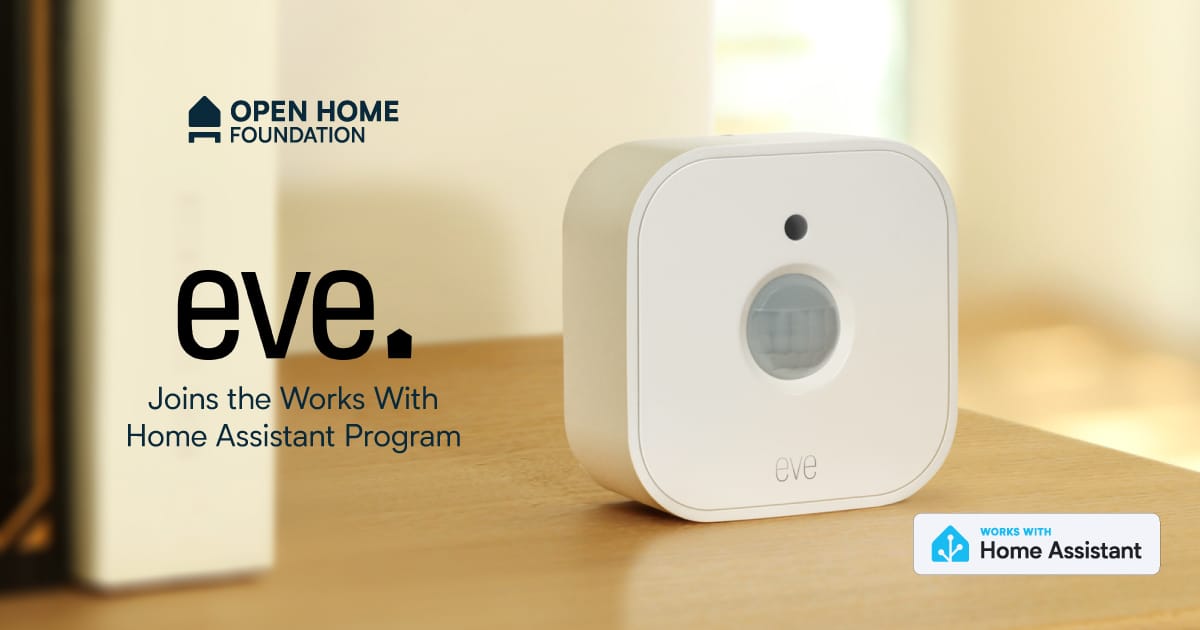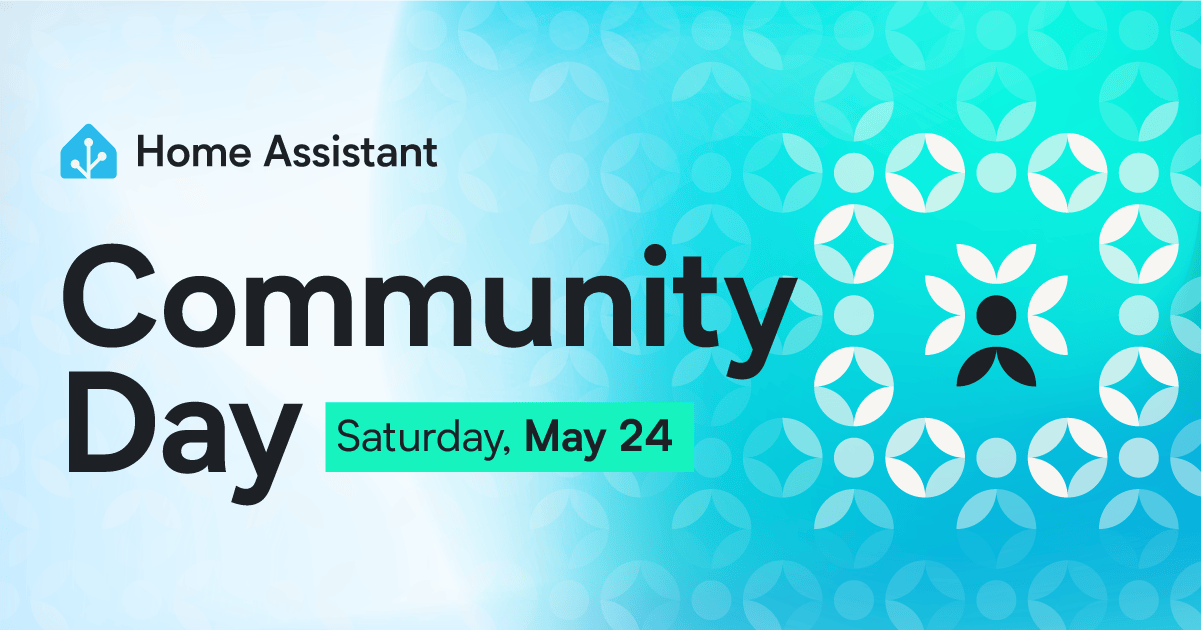Blog
Eve Joins Works With Home Assistant

We’re thrilled to announce that Eve
Eve of a New Day for the Open Home
Eve, based in Germany and part of ABB, is known for making high-quality smart home devices. They’ve been an early proponent of Matter, as it really aligns with their philosophy of local and private control. In their own words, “No Eve cloud, no registration and no tracking so your data won’t get exposed. Local intelligence and direct communication between Eve devices and smartphones or hubs without cloud dependency.”
Read on →Register today for Community Day 2025

Our first Home Assistant Community Day will be on May 24th this year 🎉, and with a month to go, here is all the information you need to take part.
The community will be leading meetups across the globe, so find your nearest event and register now
Our biggest party yet
I’m sure you’re all wondering, “Missy, what is a Community Day?”. In its simplest form, it’s a single day in which community members around the world set up local meetups with each other. That leaves a lot open, though. Where do you sign up? How do you host your own meetup? How many people should show up? Where’s the best place to hold a meetup? …that’s a lot of questions! 😳 Luckily, I have all the answers 😉.
Read on →Reolink joins Works with Home Assistant

We’re excited to announce that Reolink
Just recently, we had blinds join the program, and now we have Reolink bringing the first certified cameras and doorbells. Reolink has certified a wide range of their devices including battery-powered and wired options, as well as devices with Power-over-Ethernet (PoE) and Wi-Fi connectivity.
When someone in the Home Assistant community asks for camera recommendations, Reolink often tops the list. This strong reputation is well-earned, as they prioritize local control, don’t require cloud connectivity for their advanced features, and support open protocols whenever possible.
Read on →2 million homes strong - State of the Open Home 2025
The State of the Open Home 2025 has wrapped, and a big thanks to everyone who tuned in to the live stream! If you missed it, please check out the recording
It was an over 2-hour event, and if you need a shorter summary than this blog, here’s my best attempt 😅:
- Home Assistant doubled its user base to 2M households
- Open Home Foundation is now tax-exempt
- The Foundation has taken on 39 full-time project staff
- Espressif has donated to the Foundation
- Announced upcoming Works with Home Assistant partners
- 24 May will be Home Assistant Community Day with many meetups
- Music Assistant and HACS are now Foundation projects
- The Community Survey had 8k respondents and interesting results
- Roadmap 2025 sets out plans for a new device database
For all the juicy details, keep reading!
Read on →2025.4 Time to continue the dashboards!
Home Assistant 2025.4! 🎉
It’s April 2nd, so this is definitely not an April Fool’s joke! 😃
But before diving into this month’s release, I want to quickly highlight something you might have missed—something I’m extremely excited about:
The State of the Open Home 2025!
Yes, you read that right! On Saturday, April 12th, 2025, we’ll be
streaming a big live event on YouTube
Alright, back to the release! As I was saying, it’s April already, and we have another fantastic release lined up for you.
The big news is the introduction of our new experimental Areas dashboard, which might evolve to become the default dashboard in the future. If you’re like me—not really a UI-oriented person—you’re going to love this one! 🤩
My personal absolute favorite feature this month is something I’ve dreamed of ever since we started working on voice assistants: the ability for your assistant to start a conversation proactively! This is a game changer—no other voice assistant on the market can do this! I’m going to have so much fun with this. 😃
If you’re a power user who loves templates, don’t worry—we’ve got you covered too! This release ships with a bunch of new template functions, making your life a lot easier.
Enjoy the release!
../Frenck
Read on →Motionblinds joins Works with Home Assistant

We’re excited to announce the latest partner to join the Works with Home Assistant program is Motionblinds
Motionblinds is the first Works with Home Assistant partner to certify smart window blinds. This brings us closer to a future where you can build a smart home exclusively with certified devices that give the best possible experience with Home Assistant. Smart blinds integrated with Home Assistant unlock powerful automations, such as blinds opening when you get home, or closing sun-facing blinds on warmer days to keep your home cool.
Read on →Announcing State of the Open Home 2025
Update: It happened and was great! Read the biggest highlights here or watch the full recording
🚨On April 12th, we’re going live with this year’s State of the Open Home - our annual recap of the previous year and look ahead to the next. Just like past years, this live stream will be packed with awesome announcements, updates, and cool community highlights. (Got 11 hours to spare? Check out our last 5 State of live streams
This marks a full year since the founding of the Open Home Foundation
We’ll also be highlighting some of the big findings of our 2024 Home Assistant survey, where over 8,500 of you told us about yourself, your homes, and how you use Home Assistant. We’ll also announce Home Assistant’s 2025 roadmap, and how your feedback is shaping the future of the Open Home.
🔔 Be sure to click to get notified
Home Assistant officially Matters

Matter in Home Assistant has been officially certified! 🎉 The Connectivity Standards Alliance (CSA) has certified Home Assistant
Home Assistant, as part of the Open Home Foundation
All these benefits led us to include open standards certification in our roadmap. Home Assistant’s implementations of Matter, Zigbee, and Z-Wave are already industry-leading, so it only makes sense to clearly signal and give users peace of mind that we provide true compatibility. This most recent certification is not just big for Home Assistant, but read on to see how it also helps any open source project looking to use Matter.
Read on →2025.3: View those headers!
Home Assistant 2025.3! 🎉
But! Before I dive into the release, let me quickly catch you up on things you might have missed. There is a lot of cool stuff happening lately!
We had a live stream about Assist: Voice chapter 9
I’m also super stoked about the announcement
that Apollo Automation
And our friends at Music Assistant
Great stuff, right? But this release today is also packed with amazing things!
After a few releases focusing on backups, we are back with a release packed with new features and improvements, mostly focusing on dashboards! 🤩
The new abilities, the tile card’s fine-tuning, and the dashboard view’s new headers are really cool; I can’t wait to see screenshots of your dashboards with these new features! 📸
Enjoy the release!
../Frenck
Read on →Music Assistant's next big hit

Over the past several months, Music Assistant
Table of contents
- Optimized for Assist
- External audio & Spotify Connect
- Podcasts & Audiobooks
- More players and providers
- Equalizer control & features
- Home Assistant improvements
- More stable streaming
- Get Music Assistant 2.4 today!